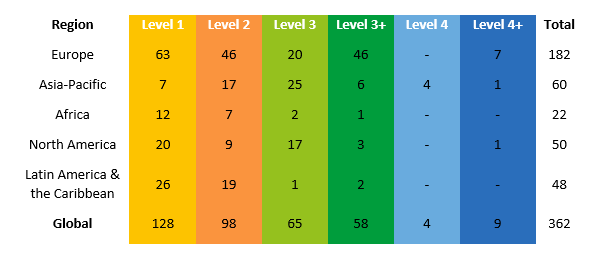Airports report continued carbon savings despite challenges of COVID-19 crisis

Worldwide carbon management standard for airports, Airport Carbon Accreditation, releases global and regional CO2 reduction results by accredited airports. The savings made are comparable to emissions from the full lifecycle of almost 5 million smartphones.
Cancun, 23 November 2021: As the global airport industry convenes in Cancun, Mexico for the 31st ACI LAC World Annual General Assembly, the Airport Carbon Accreditation programme published first carbon performance results for the reporting period May 2019 to May 2021 - two years heavily marked by the COVID-19 crisis.
In spite of the devastation suffered by the industry at large, the collective carbon management of airports in Years 11 and 121 of the programme yielded a reduction of 347,718 tonnes of CO2 (-5.5%) within the emissions under direct control of airport operators (i.e. Scope 1 and 2 as per GHG Protocol). This amount of CO2 can be compared to the full lifecycle emissions of 4,967,400 iPhones2. The following absolute emissions savings achieved by airports in their respective regions contributed to this result3:
- Africa: -5,998 tonnes of CO2 (-2.3%)
- Asia-Pacific: -73,523 tonnes of CO2 (-2.6%)
- Europe: -154,432 tonnes of CO2 (-7.9%)
- Latin America & the Caribbean: -6,787 tonnes of CO2 (-7.7%)
- North America: -106,979 tonnes of CO2 (-8.3%)
Since the onset of the COVID-19 pandemic in March 2020, despite the dire financial and operational conditions, 67 new airports joined the global effort to mitigate carbon emissions and thus became certified under Airport Carbon Accreditation. Currently, there are 362 airports addressing carbon emissions across the six levels of the programme.
Olivier Jankovec, ACI EUROPE Director General said: “There is no more ruthless test for an industry’s pledges to address its environmental footprint than being exposed to a crisis. When we look at the COVID-19 crisis, the magnitude of challenges it presents for the aviation industry and airports in particular is historical. Faced with terrible odds, it would have been easy to say, “We cannot do this right now. We need to put out one fire first, before we can address the next one”, but this is exactly the opposite of what I have witnessed so far. The shift in the aviation industry’s commitment and indeed delivery of climate action is palpable.”
He added: “I am proud to note that airports are not sitting on the sidelines of this momentum, waiting for the bigger emitters in the sector to move first. Airports have always been and are today a powerhouse of decarbonisation - and today’s announcement is another case in point for this claim. We are addressing our slice of the problem right now while making sure that we will be reliable partners for the entire eco-system in its drive to transform in the future. It is a defining moment for our industry and seeing the ambition and the perseverance that is shining through airports’ efforts in driving CO2 emissions down is a source of hope in this difficult time.”
Find out more about the programme and access the full list of accredited airports on www.airportcarbonaccreditation.org.
1 Due to the extraordinary conditions faced in 2020, special provisions were applied to all accredited airports, including the merge of programme Years 11 and 12, which implied the extension of accreditation validity by one year. While the reporting period is May 2019 - May 2021, each airport submitted only one 12-months-carbon footprint in this timeframe. Therefore, the reduction was achieved within one year, but reported at different moments in a two-year-period.
2 This equivalent was calculated based on this recent article quoting the lifecycle emissions of smartphones. In this case, iPhone 12 emissions were used as comparator (70kg CO2e). This figure should not be treated as scientifically confirmed information, as it’s drawn for visualisation purposes only. Please note that CO2 equivalents by their nature are an indicative tools, as emissions vary based on many factors, including usage patterns, geographic location, quality of energy and processes at production facilities, etc.
3 Additional carbon performance data as well as a comprehensive overview of other programme developments and airport case studies for the period 2019-2021 will be published in the forthcoming Airport Carbon Accreditation Annual Report, planned for Q1 2022.



